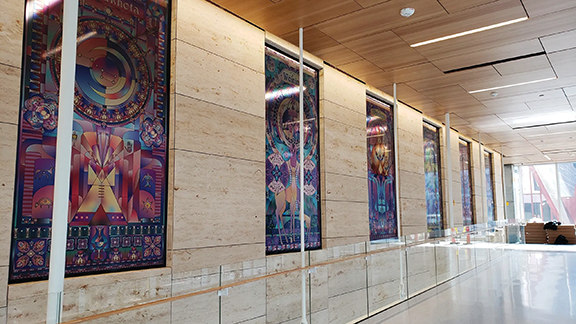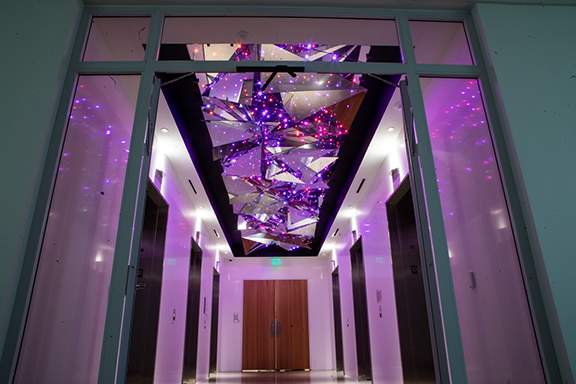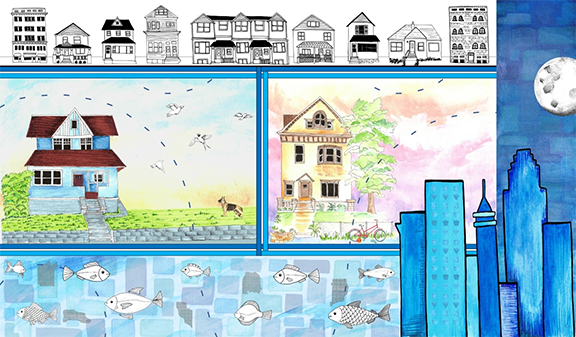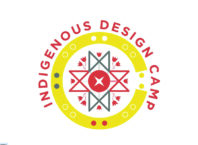
By Lee Egerstrom
The COVID-19 pandemic and continuing outbreaks of variant strains hurt artists about as much as any group of creative entrepreneurs but Twin Cities public works projects are helping keep three Native American artists toiling in their fields.
In early December, the City of Minneapolis held an open house at its new Public Service Building, 505 Fourth Ave. S. across the street from City Hall, to showcase 17 major artworks included in the new civic building. Among these paintings and sculptures were works by prominent Twin Cities Native artists Rory Wakemup, Marlena Myles and Angela Two Stars.
In late December, the City of St. Paul stepped forward and announced it had chosen two local artists – Myles and Wakemup – to develop multiple art forms for the huge Highland Bridge development site near the Mississippi River. It is on the old Ford Motor assembly plant grounds in St. Paul.

Art is personal for both the artist and a buyer or someone appreciating the art, said Wakemup. “That relationship is hard (to keep) with the pandemic.”
Public works projects, however, are planned and budgeted over time and do continue on, he said. “This keeps us going post-pandemic,” he said.
The Dec. 22 announcement from St. Paul and its Public Arts Saint Paul unit said Wakemup and Myles were unanimously chosen. A field of 170 artists from across the U.S. submitted proposals to provide art for the $146,000 public arts portion of the development.
What St. Paul officials saw and appreciated is that Wakemup (Boise Forte Ojibwe), an artist, activist and community organizer; and artist Myles (Spirit Lake Dakota/Mohegan/Muscogee) want to connect the Highland Bridge project’s location by the Mississippi River with its historic homeland area for the Dakota people.
The public art project will help visitors and area St. Paul residents understand the Dakota people who lived in this center area of what is now the Twin Cities and appreciate the culture and stories of the Indigenous Twin Citians.
The artists’ proposal is called The Story of Creation that will combine sculpture, murals and newer art forms, such as a website and handheld technology devices, to share these stories and history.

Myles told The Circle that some research is still underway on where different artworks will be installed. The artwork is to be completed in 2022 and will be placed in UiMaka (Grandmother Earth) Park, a new park being built within the 135-acre Highland Bridge project.
In the city’s announcement of the artists’ selection, Myles said she looks forward to creating artwork to “honor the significance to our homelands and pass on the teachings of Unci Maka (Grandmother Earth) Park to the future generations.
The historical ties to the Dakota presence were stressed in the city’s announcement. Colleen Sheehy, executive director of Public Art Saint Paul, said the art will “weave together the past, present and future” referencing Dakota stories and beliefs from hundreds of years. It will allow people to use cutting edge technology, such as cell phones, to access and share images and these stories.
St. Paul City Council member Chris Tolbert, who represents the southwest St. Paul district by the river, added to the historical ties to the Dakota. “With water flowing from the Unci Maka Park to nearby Bdote (where Haha Wakpa, or Mississippi River, and Mnísota Wakpá, the Minnesota River) come together, the area “is central to Dakota spirituality and history,” Tolbert said.
Art is fulfilling at many levels. Education about people, places and how they connect to make histories and traditions is among art’s greatest contributions. As a result, public art is usually supported by designated allotments from capital improvement projects such as 1 percent of revenues raised from public bond sales.
The Minneapolis Public Service Building is an example of these connections. The building now has artwork from 17 artists on display, including elevator lobby ceiling sculptures and bird-safe glass and vinyl murals.
Like the city itself, the collection of art is from a diverse group of artists. Many have works on display around the Twin Cities. They include Tristan Al-Haddad, Laurie Borggreve, James Brenner, Christopher Harrison, Iroha Ito, John Kim, Andrew Lucia, Adama Marcus, Aaron Marx, Molly Reichert, Connor Rice, Will Siasoco, Alexander Tylevich and Kao Lee Thao in addition to Myles, Two Stars and Wakemup.
The city said goals for its public art project include having public space in an inviting and pleasant place, reflect the city’s diversity and culture, and reflect the mission of public service.

artwork is now on display at the new Minneapolis Public Service Building, 505 Fourth Ave. S. in Minneapolis. (Photos courtesy of Mary Altman, Supervisor of Public Arts, City of Minneapolis – Community Planning and Economic Development.)
The three Native artists contributed to those goals.
Myles has two ink on vinyl murals displayed. One of them, Protecting the Generations, is on the skyway ramp and the other, Indigenous Wealth, is on a sixth-floor hallway. Both carry forward her use of Dakota language and storytelling.
In Protecting the Generations, Myles uses Wódakhota (harmony with all life), Wichoichage (generations/growth of the people), Wóabdeza (understanding), Wóinina (awareness of silence), Wichóhan (responsibility/way of life), and Wótakuye (relatives/kinship) as lessons with Dakota words.
Indigenous Wealth, meanwhile, projects Dakota history in Minneapolis and gives lessons for how to care for community going forward. It notes how Minneapolis economic wealth was created around Saint Anthony Falls that had different economic meaning to the Dakota. One example is the legend of where the “Horse Nation” met the Dakota/Lakota people and that horses would bring economic benefits to the people.
This mural also teaches that within the “tribes’ thiyó paye (community), one must be a good relative to one another and to the natural and supernatural worlds.” This, the city’s virtual tour notes, becomes a way to encourage all to be “stewards” of the city for future generations,
Wakemup’s Anangokaa, or “There are Many Stars,” is a mirrored polycarbonate and lighting ceiling sculpture on a closed floor only visible to the general public under special arranged tours. It salutes water and the star-filled night sky, both relevant to city, state and Indigenous peoples’ lifestyles and culture.
Two Stars (Sisseton Wahpeton Oyate), has an ink on vinyl mural on the eighth-floor hallway that stresses public service. Called The Number One Goal, it shows cityscape, housing and neighborhood views that depict home and caring for community. In words for the city’s tour material, Two Stars described it:
“An acknowledgement of understanding and empathy for a job often thankless and judged, my work acts to distract from what cannot be forgotten and highlights the experiences of those in law enforcement.”
Two Stars is currently the director of the All My Relations Arts in Minneapolis. Information about her artwork can be found at http://www.angelatwostars.com and https://www.minnesotamonthly.com/lifestyle/people/qa-the-rise-of-artist-angela-two-stars-in-the-twin-cities.
Wakemup doesn’t have a website to promote his artwork or community activism, relying instead “on the moccasin telegraph,” he said. But that works. He has been involved in several high attention-grabbing actions including the thousand red dresses placed on the State Capitol grounds for the May 5 National Day of Awareness for Missing and Murdered Native Women and Girls.
Myles has extensive Internet coverage on her artwork and activities. It can be accessed at her website https://marlenamyl.es/about. A special public art presentation is explained at https://marlenamyl.es/dakota-spirit-walk for her work at the Bruce Vento Nature Sanctuary in downtown St. Paul.
She also has Wíyou kihipi (We Are Capable) Productions, a publishing house for Dakota language and culture and is a special resource house for children’s books. It has a website at http://wiyounkihipi.com.
A virtual tour of the artwork is available on the Internet at https://storymaps.arcgis.com/stories/b5137fe509354f6c80ae49ac487ad09f.






